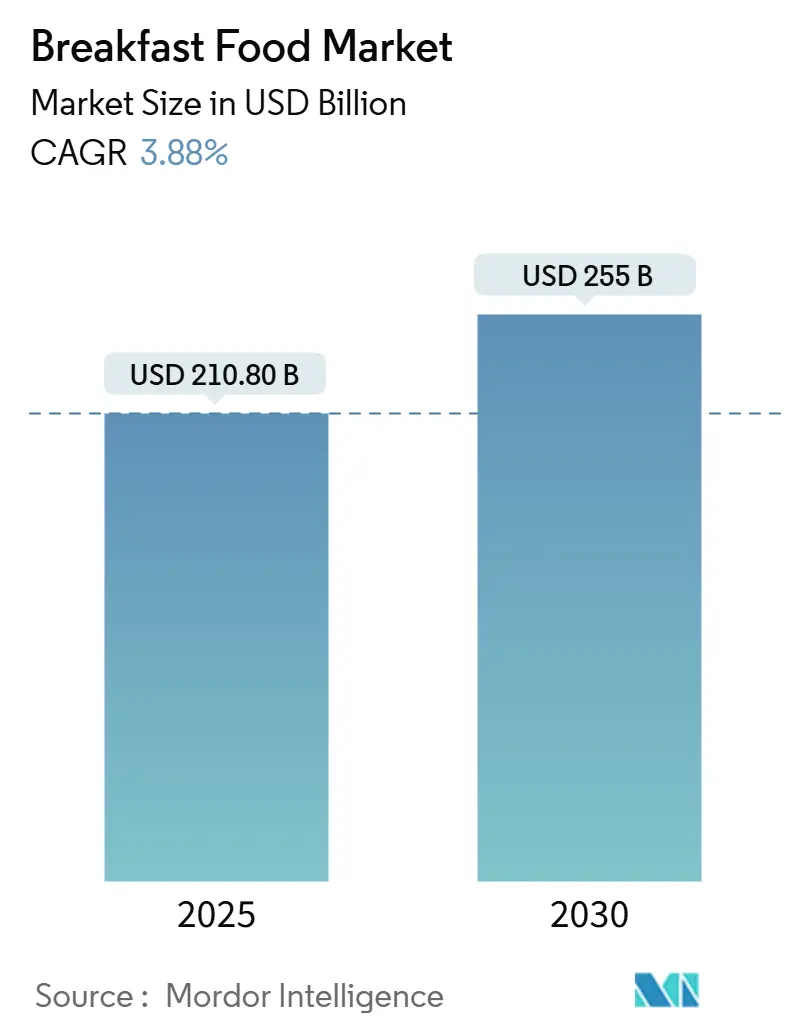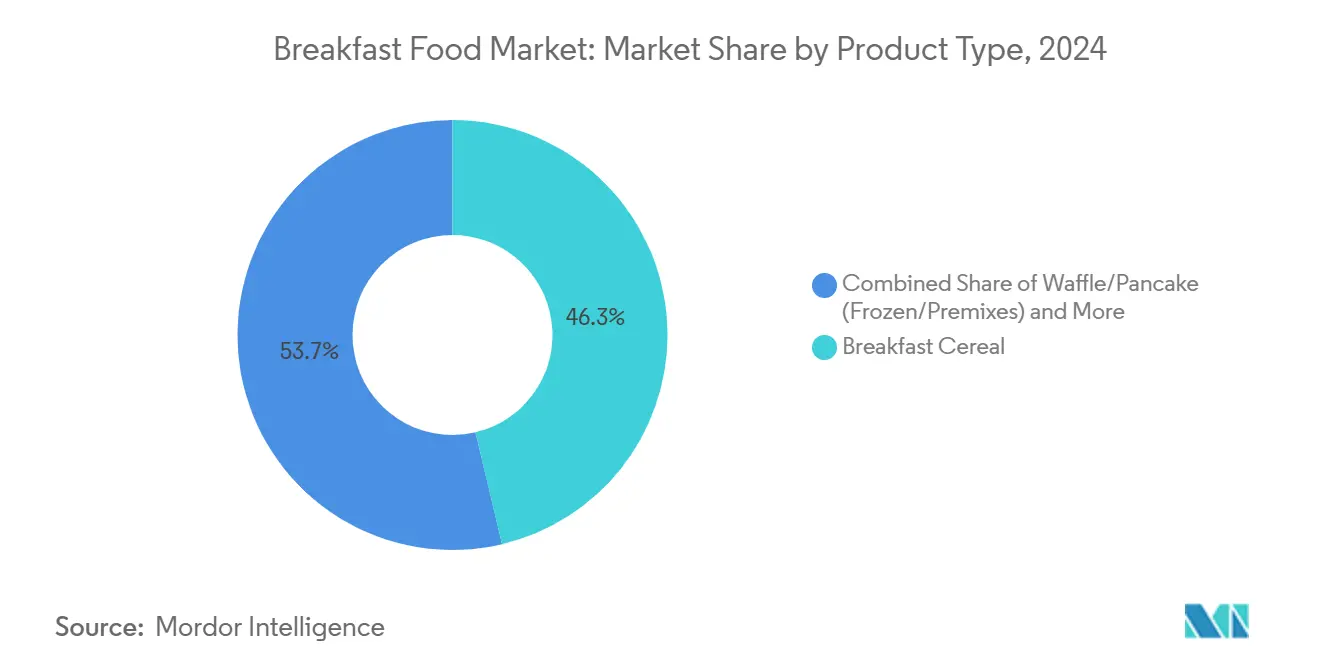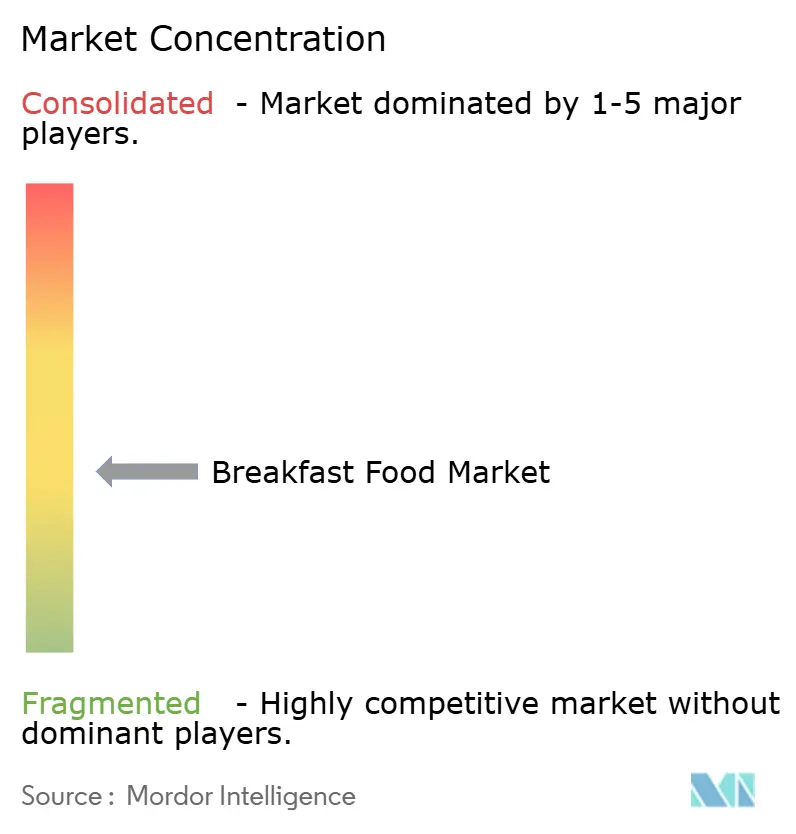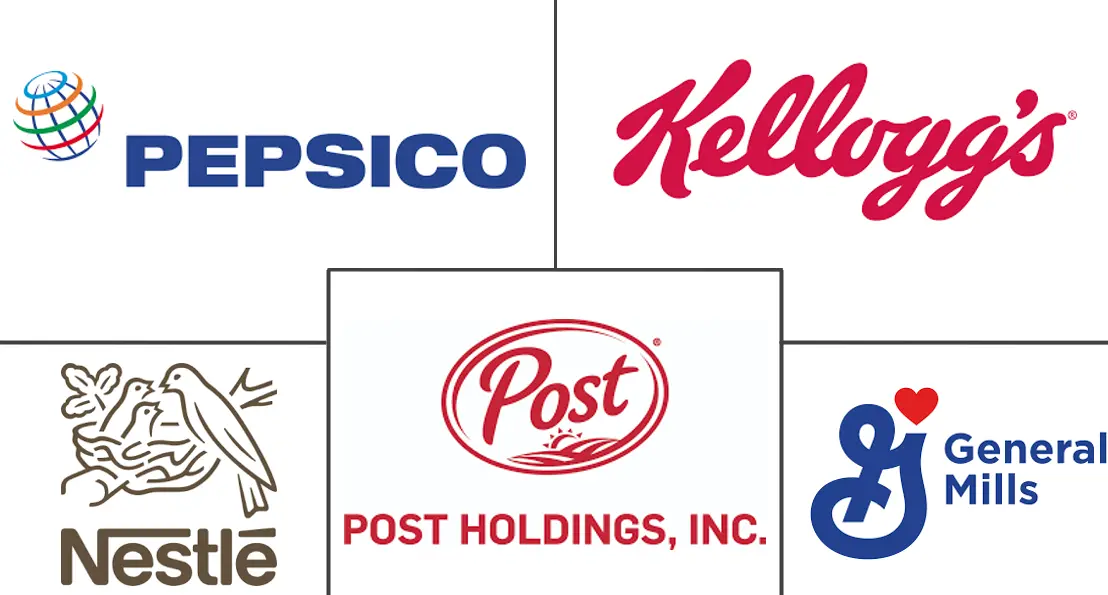Breakfast Food Market Size and Share

Breakfast Food Market Analysis by Mordor Intelligence
In 2025, the global breakfast food market was valued at USD 210.80 billion. Projections indicate it will climb to USD 255.00 billion by 2030, marking a steady CAGR of 3.88%. This moderate growth signals a shift in a mature landscape, transitioning from sheer volume expansion to a focus on premiumization. This shift is largely driven by tightening nutritional regulations, rising wellness aspirations, and the swift adoption of digital retail. Furthermore, the global emphasis on breakfast underscores the market's upward trajectory. A November 2024 survey by Japan's Ministry of Agriculture, Forestry, and Fisheries revealed that a significant 78% of Japanese consumers enjoy breakfast daily[1]Source: Japan's Ministry of Agriculture, Forestry, and Fisheries, "Survey Report on Dietary Education 2025", www.maff.go.jp. The FDA's revamped "healthy" definition has intensified R&D investments and the use of clean-label ingredients. This shift bolsters the competitive stance of larger players adept at navigating the intricacies of cost, compliance, and innovation. The rising appetite for organic, free-from, and functional products is pushing up average selling prices. Simultaneously, the infusion of diverse cultural flavors is expanding consumption moments and enhancing product exploration in the breakfast sector. Mars' acquisition of Kellanova in August 2024 underscores a trend: companies are merging to create broader portfolios and operational efficiencies, countering challenges like commodity price swings and sustainability-driven packaging demands.
Key Report Takeaways
- By product type, breakfast cereals held 46.30% of the breakfast food market share in 2024, whereas waffle and pancake products are projected to expand at a 5.80% CAGR through 2030.
- By category, conventional items accounted for 82.73% of the breakfast food market size in 2024, while organic and free-from lines are poised to grow at a 6.47% CAGR.
- By distribution channel, supermarkets and hypermarkets led with 33.82% revenue share in 2024; online retail is the fastest channel at a 7.90% CAGR to 2030.
- By geography, North America commanded 32.43% of the breakfast food market in 2024, but the Asia Pacific is anticipated to advance at a 6.56% CAGR through 2030.
Global Breakfast Food Market Trends and Insights
Driver Impact Analysis
| Driver | (~) % Impact on CAGR Forecast | Geographic Relevance | Impact Timeline |
|---|---|---|---|
| Increased Health and Wellness Awareness | +0.8% | Global, with premium penetration in North America & Europe | Medium term (2-4 years) |
| Product Innovation and Variety | +0.6% | Global, led by Asia-Pacific cultural fusion and North America premiumization | Long term (≥ 4 years) |
| Advancements in Packaging Technology | +0.4% | Global, with a sustainability focus in Europe and North America | Medium term (2-4 years) |
| Fusion of Cultural Flavors | +0.5% | Asia-Pacific core, spill-over to North America and EU urban markets | Long term (≥ 4 years) |
| Shifting Dietary Preferences | +0.7% | Global, with plant-based adoption highest in North America & Europe | Medium term (2-4 years) |
| Growing Demand for Organic and Clean Label Products | +0.9% | North America & EU primary, emerging in Asia-Pacific affluent segments | Long term (≥ 4 years) |
| Source: Mordor Intelligence | |||
Increased Health and Wellness Awareness
As consumers increasingly scrutinize ingredient lists and nutritional profiles, health consciousness is reshaping breakfast categories. The FDA's February 2025 update to the definition of "healthy" imposes stricter thresholds on sodium, saturated fat, and added sugars. This change compels manufacturers to reformulate their products or risk losing their health positioning. In Japan, consumers are not only showing interest in gut health functional foods but are also on the lookout for sleep-aid products. This creates a fertile ground for breakfast items that offer targeted wellness benefits. Data from the Japan Dairy Council reveals that in fiscal year 2023, the average annual per capita expenditure on yogurt in Japan rose to approximately YEN 4.8 thousand, up from YEN 4.5 thousand the previous year[2]Source: Japan Dairy Council, "Average annual per capita expenditure on yoghurt in Japan", www.dairy.or.jp. Such shifts in consumer behavior favor larger companies with strong R&D and regulatory compliance capabilities, potentially sidelining smaller players who lack the resources for reformulation. While there's a noticeable premiumization trend, with consumers willing to pay more for perceived health benefits, it's essential to note that price sensitivity remains high in certain segments.
Product Innovation and Variety
As markets become saturated, brands are accelerating their innovation cycles, introducing novel formats, flavors, and functional benefits to stand out. In 2025, General Mills unveiled eight new breakfast products, from protein-enhanced cereals to licensed character cereals, showcasing how established players are capitalizing on brand equity for line extensions. In Korea, Shinsegae Food rolled out a probiotic rice bread made from domestic rice flour and patented gluten-degrading probiotics, boasting a remarkable 12% month-on-month sales growth and surpassing 600,000 units in cumulative sales. Partnerships across categories are on the rise, highlighted by Thomas' August 2024 tie-up with WK Kellogg for Froot Loops bagels and Kellanova's collaboration with Two Rivers Coffee Co. for Eggo coffee. These alliances are crafting hybrid products that challenge traditional category definitions. Today, the success of innovations hinges more on swift market entry and precise consumer insights than on sheer R&D expenditure.
Advancements in Packaging Technology
Driven by sustainability mandates and heightened consumer environmental awareness, packaging innovation now transcends traditional focuses on cost and shelf-life. In a notable move, Post Cereal pledged to adopt 100% recyclable packaging. Meanwhile, in May 2024, General Mills unveiled its "Smart Pour" technology for Wheaties, underscoring how functional enhancements can set apart commodity products. In Australia, yogurt producers are shifting to paper packaging, and coffee brands are rolling out compostable pod solutions. These trends highlight a cross-category sustainability knowledge transfer, particularly benefiting breakfast food applications. As governments roll out extended producer responsibility schemes and set plastic reduction targets, the pressure mounts for regulatory compliance. Such dynamics play to the advantage of larger manufacturers, equipped with dedicated sustainability teams and robust supplier relationships. In contrast, smaller players, often devoid of resources for packaging innovation, find themselves at a distinct disadvantage.
Fusion of Cultural Flavors
As globalization and travel broaden horizons, consumers are increasingly embracing flavors beyond their traditional regional preferences. Unilever's Future Menus 2025 report highlights a growing global palate: Asian flavors, especially Chinese and Japanese, now rank among the top five favorites across all age groups. Meanwhile, Korean and Mexican influences are making swift gains. This evolving taste landscape paves the way for breakfast products to adopt profiles like umami, fermentation, and spices, which were once reserved for other meals. Companies adeptly navigating this cultural fusion showcase a profound understanding of local markets, all while upholding a consistent global brand image. This trend is particularly advantageous for Asia Pacific manufacturers, armed with authentic cultural insights, and for North American and European firms, which boast robust innovation and cultural adaptation skills.
Restrains Impact Analysis
| Restraint | (~) % Impact on CAGR Forecast | Geographic Relevance | Impact Timeline |
|---|---|---|---|
| Health Concerns Over Processed Foods | -0.6% | Global, with the highest impact in health-conscious North America & Europe markets | Medium term (2-4 years) |
| Competition from Alternative Meal Options | -0.4% | Global, with meal replacement trends strongest in urban markets | Short term (≤ 2 years) |
| Sourcing and Agricultural Dependencies | -0.5% | Global, with commodity exposure highest in cost-sensitive segments | Short term (≤ 2 years) |
| Nutritional and Flavor Limitations of Alternatives | -0.3% | Global, with premium segments more tolerant of trade-offs | Medium term (2-4 years) |
| Source: Mordor Intelligence | |||
Health Concerns Over Processed Foods
As consumers increasingly link breakfast cereals, bars, and packaged items to artificial additives, high sugar content, and low nutritional value, skepticism towards processed foods grows. Highlighting this trend, Congress has pressured the FDA to ban FD&C Red No. 3 from foods, citing concerns over its carcinogenicity and referencing California's AB 418. This regulatory push could reshape breakfast food formulations. Traditional cereal categories, in particular, feel the brunt of this skepticism, facing heightened scrutiny over sugar content and artificial coloring from both health advocates and regulatory entities. Furthermore, a rising preference for clean-label foods underscores this wariness towards processed items. A 2023 survey by the International Food Information Council revealed that about 29% of U.S. respondents regularly purchase food and beverages labeled with "clean ingredients"[3]Source: International Food Information Council, "Food & Health Survey 2023", www.ific.org. In response, manufacturers are reformulating products and enhancing transparency. However, these initiatives demand substantial R&D investments and risk altering the taste profiles that consumers favor. Yet, this challenge also presents brands with a chance to market their products as minimally processed, all while ensuring they meet convenience and taste expectations.
Competition from Alternative Meal Options
Shifting consumer preferences and dietary trends have intensified competition in the global breakfast food market, posing a significant challenge. The market now brims with convenient and nutritious products, such as meal replacement shakes, high-protein bars, and energy drinks, which aren't exclusively labeled as breakfast items. Notable product launches in 2024 and 2025 underscore the mounting competition from these alternatives. In early 2024, Abbott Laboratories unveiled its high-protein shake, PROTALITY, targeting consumers focused on weight loss and muscle building, effectively positioning it as a breakfast replacement. Furthermore, in 2024, brands like Soylent broadened their high-protein shake offerings to cater to "on-the-go" consumers in search of a nutritionally complete meal. The functional snack bar segment also witnessed notable innovations in 2024 and 2025, introducing products enriched with adaptogens, nootropics, and probiotics, targeting health benefits like gut health and mental clarity. These innovations present a direct challenge to traditional breakfast bars and cereals. Such advancements from outside the traditional breakfast realm are vying for the title of the "first meal of the day," highlighting the encroachment of alternative meal options on the market share of dedicated breakfast products.
Segment Analysis
By Product Type: Cereals Face Innovation Pressure
In 2024, breakfast cereals command a 46.30% market share, bolstered by brand loyalty and distribution advantages. However, they grapple with challenges as health-conscious consumers scrutinize sugar content and processing methods. Waffle and pancake products, encompassing both frozen and premix formats, are projected to grow at a 5.80% CAGR through 2030. These products cater to busy lifestyles, offering customizable indulgent experiences while preserving breakfast authenticity. In 2025, General Mills launched 8 new breakfast products, including protein cereals and character-licensed varieties. This move underscores how established players leverage innovation and brand extension strategies to fortify their market position. While bakery products thrive on premiumization trends and artisanal branding, breakfast bars and granola products seize on-the-go consumption moments, a space where traditional cereals fall short.
Dairy and its alternatives showcase divergent growth patterns. Traditional dairy grapples with pressures from plant-based substitutes, while alternative products carve a niche, gaining traction through foodservice collaborations and enhanced taste profiles. This segment's transformation mirrors a broader societal shift towards sustainability and health, presenting opportunities for companies adept at balancing taste, nutrition, and price across varied consumer demographics. The USDA's organic labeling mandates, which require 95% organic ingredients for "organic" claims, introduce regulatory challenges. These regulations favor established players with the necessary certification infrastructure, while potentially sidelining smaller manufacturers who lack access to an organic supply chain.

Note: Segment shares of all individual segments available upon report purchase
By Category: Conventional Dominance Faces Premium Challenge
In 2024, conventional breakfast foods dominate the market with an 82.73% share, thanks to their price accessibility and widespread distribution. However, organic and "free-from" alternatives are on the rise, boasting a 6.47% CAGR through 2030. This surge is driven by affluent consumers who prioritize health and environmental benefits over cost. The contrasting growth rates highlight a market polarization: mainstream consumers are more price-sensitive, while a premium-willing segment is health-conscious. This divide necessitates distinct strategic approaches from manufacturers, tailoring their tactics to different demographic and income groups. A case in point is Shinsegae Food, a Korean company, which has seen its probiotic rice bread grow 12% month-on-month leading up to March 2025, thanks to premium positioning and a focus on health benefits.
The organic segment enjoys a competitive edge, bolstered by the USDA National Organic Program's stringent standards. These standards mandate certified organic production methods and ban synthetic inputs, creating barriers that shield compliant manufacturers from non-certified rivals. Meanwhile, the clean label trend has evolved. It's no longer just about organic certification; consumers now demand ingredient transparency, minimal processing, and a clear avoidance of additives. This shift underscores a growing consumer sophistication, where genuine authenticity is valued over mere marketing claims. As the category continues to evolve, brands that can adeptly communicate their value propositions, while ensuring operational efficiency and competitive pricing, stand to gain from premiumization opportunities.
By Distribution Channel: Digital Transformation Accelerates
Online retail channels are projected to grow at a 7.90% CAGR through 2030. In 2024, supermarkets and hypermarkets are set to hold a 33.82% market share. These trends underscore a lasting shift towards digital convenience and subscription models, often sidestepping traditional retail intermediaries. The rise of online retail channels is advantageous for brands with direct-to-consumer capabilities and advanced data analytics. In contrast, it poses challenges for traditional manufacturers reliant on retail partnerships and shelf space negotiations.
Convenience stores and other distribution channels cater to specialized consumption moments and impulse buys, complementing primary retail channels rather than competing with them. This evolving distribution landscape presents opportunities for brands adept at fine-tuning channel-specific assortments, pricing, and consumer engagement, all while ensuring a unified brand image. Digital transformation is especially advantageous for premium and niche brands, allowing them to connect with specific consumer segments without the hurdles of traditional retail. However, achieving this success demands significant investments in e-commerce infrastructure, fulfillment, and digital marketing expertise, posing challenges for smaller manufacturers.

Geography Analysis
North America commands a dominant 32.43% share of the breakfast food market, bolstered by ingrained breakfast traditions and a robust cold-chain infrastructure. This infrastructure adeptly handles everything from protein yogurts and freezer waffles to fresh juice bundles. While the FDA's nutrient thresholds drive up reformulation costs, established cereal giants leverage scale efficiencies and cutting-edge R&D labs, ensuring compliance without losing valuable shelf space. The trend of premiumization fuels margin growth, as seen in protein-enhanced cereal lines that, despite their elevated price points, maintain strong sales velocity due to their fitness-centric appeal.
Asia Pacific stands out as the most vibrant region, boasting a projected CAGR of 6.56% through 2030. Here, urbanization and increasing disposable incomes meld with Western dining trends, leading to a surge in demand for on-the-go bread rolls, single-serve fortified porridge cups, and flavored plant-based milks. Local players like Glico are introducing almond protein drinks, catering to the region's lactose-intolerant populace. Simultaneously, global brands are collaborating on culturally resonant flavors, such as black sesame granola and pandan waffles. Moreover, government initiatives promoting healthier school meals are bolstering breakfast consumption, benefiting supermarket sales of fortified cereal pouches.
Europe, South America, and the Middle East & Africa each bring their unique flavor to the breakfast food landscape. Europe's market growth is closely tied to eco-friendly packaging, oat-based beverages, and reduced-sugar muesli—aligning with the EU Green Deal's sustainability targets. In South America, while the region's rich grain production supports competitively priced private labels, fluctuations in purchasing power limit the appetite for premium products. Meanwhile, urban expansion in Gulf Cooperation Council nations and sub-Saharan Africa is driving demand for ready-to-eat cereals and frozen pastries, with adaptations for halal standards and environmentally-conscious storage. Across all regions, it's crucial to align flavor profiles, packaging sizes, and certification labels with local preferences for lasting market presence.

Competitive Landscape
In the breakfast food market, competition remains moderate, with the top five global players accounting for just under 60% of the category's revenue. Mars made headlines in August 2024 with its USD 35.9 billion acquisition of Kellanova, bringing together prominent cereal and frozen waffle brands, thereby enhancing its distribution reach. General Mills, in a bid to innovate swiftly, rolled out eight distinct SKUs within a single year, marking a shift from long-term blockbuster strategies to quicker ideation cycles. Post Holdings is championing eco-friendly initiatives with its commitment to fully recyclable packaging, a move that not only appeals to environmentally-conscious consumers but also acts as a buffer against impending plastic taxes.
New entrants are carving their niche in two primary ways: plant-based brands emphasizing sustainability and digitally-savvy companies leveraging social media to sidestep traditional shelf fees. Oatly's partnerships with cafes highlight the power of experiential sampling in promoting alternative milks, challenging the dominance of traditional dairy products. Armed with insights from retailers, private labels are adeptly replicating popular flavors and nutritional profiles at competitive prices, thereby squeezing profit margins in the breakfast food sector. As companies consider vertical integration of essential inputs like oats, almonds, and eggs, the focus on supply-chain resilience emerges as a key strategy to navigate inflationary pressures and disease-related shortages.
There's potential in merging functional advantages with indulgence and cultural authenticity. For instance, collagen-infused pancakes cater to beauty-conscious consumers, while kimchi-flavored cereal clusters entice the more adventurous snackers. Collaborations between flavor experts and grain processors are expediting product development. At the same time, investments in precision-fermentation proteins and upcycled grain fibers hint at a tech-driven evolution in the industry, promising not just cost recalibration but also enhanced nutritional value.
Breakfast Food Industry Leaders
-
Kellogg Company
-
Nestlé S.A.
-
General Mills Inc.
-
PepsiCo Inc.
-
Post Holdings Inc.
- *Disclaimer: Major Players sorted in no particular order

Recent Industry Developments
- June 2024: Marico expanded its breakfast offerings in India as it launched Saffola Muesli. The product aimed to leverage the brand's equity in the adult breakfast segment and capitalize on the growing demand for healthy breakfast foods. The strategic move was designed to capitalize on the Saffola brand's strong equity in the healthy adult breakfast segment, building on its success in the oats and extensions into products like honey and peanut butter.
- May 2024: Kellanova launched a protein-enriched version of its Eggo waffles, designed to appeal to health-conscious consumers. The new product contained 10 grams of protein per two-waffle serving, aligning with the growing demand for protein-focused breakfast options.
- January 2024: General Mills introduced several new products, including new flavors and varieties of Cheerios (e.g., Cheerios Veggie Blends and Honey Nut Cheerios Minis) and snack bars (e.g., Cocoa Puffs Soft Baked Oat Bars, Nature Valley Protein Smoothie Bar, and French Vanilla Protein Granola). The launch catered to consumer demand for health-conscious and convenient breakfast options.
- January 2024: PepsiCo India expanded its Quaker oats portfolio as it launched a new range of instant oats in three flavors. The company focused on smaller pack sizes to increase distribution and appeal to more consumers seeking healthier, grain-based breakfast options.
Global Breakfast Food Market Report Scope
Breakfast is eaten primarily as the first meal of the day. Breakfast can be cereal grains like oats, muesli, wheat, and corn. As it is the first meal of the day, breakfast is expected to be highly nutritious, and it should provide energy for the whole day.
The breakfast food market is segmented by product type, distribution channel, and geography. Based on product type, the market is segmented into cereals, beverages, snack bars, and ready meals. By distribution channel, the market has been segmented into hypermarkets/supermarkets, convenience stores, specialty stores, online retailers, and other distribution channels. By geography, the market has been segmented into North America, Europe, Asia-Pacific, South America, and Middle East and Africa. For each segment, the market sizing and forecasts have been done based on value (in USD million).
| Breakfast Cereal |
| Bakery Products |
| Breakfast bars and granola |
| Dairy and dairy alternatives |
| Waffle/Pancake (Frozen/Premixes) |
| Conventional |
| Organic/Free-from |
| Supermarkets/Hypermarkets |
| Convenience Stores |
| Online Retail Stores |
| Other Distribution Channels |
| North America | United States |
| Canada | |
| Mexico | |
| Rest of North America | |
| South America | Brazil |
| Argentina | |
| Colombia | |
| Chile | |
| Rest of South America | |
| Europe | United Kingdom |
| Germany | |
| France | |
| Italy | |
| Spain | |
| Russia | |
| Sweden | |
| Belgium | |
| Poland | |
| Netherlands | |
| Rest of Europe | |
| Asia-Pacific | China |
| Japan | |
| India | |
| Thailand | |
| Singapore | |
| Indonesia | |
| South Korea | |
| Australia | |
| New Zealand | |
| Rest of Asia-Pacific | |
| Middle East and Africa | United Arab Emirates |
| South Africa | |
| Saudi Arabia | |
| Nigeria | |
| Egypt | |
| Morocco | |
| Turkey | |
| Rest of Middle East and Africa |
| By Product Type | Breakfast Cereal | |
| Bakery Products | ||
| Breakfast bars and granola | ||
| Dairy and dairy alternatives | ||
| Waffle/Pancake (Frozen/Premixes) | ||
| By Category | Conventional | |
| Organic/Free-from | ||
| By Distribution Channel | Supermarkets/Hypermarkets | |
| Convenience Stores | ||
| Online Retail Stores | ||
| Other Distribution Channels | ||
| By Geography | North America | United States |
| Canada | ||
| Mexico | ||
| Rest of North America | ||
| South America | Brazil | |
| Argentina | ||
| Colombia | ||
| Chile | ||
| Rest of South America | ||
| Europe | United Kingdom | |
| Germany | ||
| France | ||
| Italy | ||
| Spain | ||
| Russia | ||
| Sweden | ||
| Belgium | ||
| Poland | ||
| Netherlands | ||
| Rest of Europe | ||
| Asia-Pacific | China | |
| Japan | ||
| India | ||
| Thailand | ||
| Singapore | ||
| Indonesia | ||
| South Korea | ||
| Australia | ||
| New Zealand | ||
| Rest of Asia-Pacific | ||
| Middle East and Africa | United Arab Emirates | |
| South Africa | ||
| Saudi Arabia | ||
| Nigeria | ||
| Egypt | ||
| Morocco | ||
| Turkey | ||
| Rest of Middle East and Africa | ||
Key Questions Answered in the Report
What is the current global value of the breakfast food market?
The breakfast food market size reached USD 210.80 billion in 2025 and is projected to hit USD 255.00 billion by 2030.
Which product category leads global revenue?
Breakfast cereals remain the largest contributor, holding 46.30% of the breakfast food market share in 2024.
Which region is expected to grow the fastest through 2030?
Asia Pacific is forecast to expand at a 6.56% CAGR as urbanization and Western meal patterns boost demand.
How are online channels shaping category growth?
E-commerce is advancing at a 7.90% CAGR, aided by subscription models and dynamic pricing strategies on platforms such as Amazon.
What regulatory change is most influencing product reformulation?
The FDA’s 2025 “healthy” definition enforces lower sugar, saturated fat, and sodium thresholds, spurring widespread recipe updates.
Which consumer trend is lifting premium price realization?
Growing demand for organic and clean-label breakfast foods is driving faster growth—6.47% CAGR—within premium tiers.
Page last updated on:



